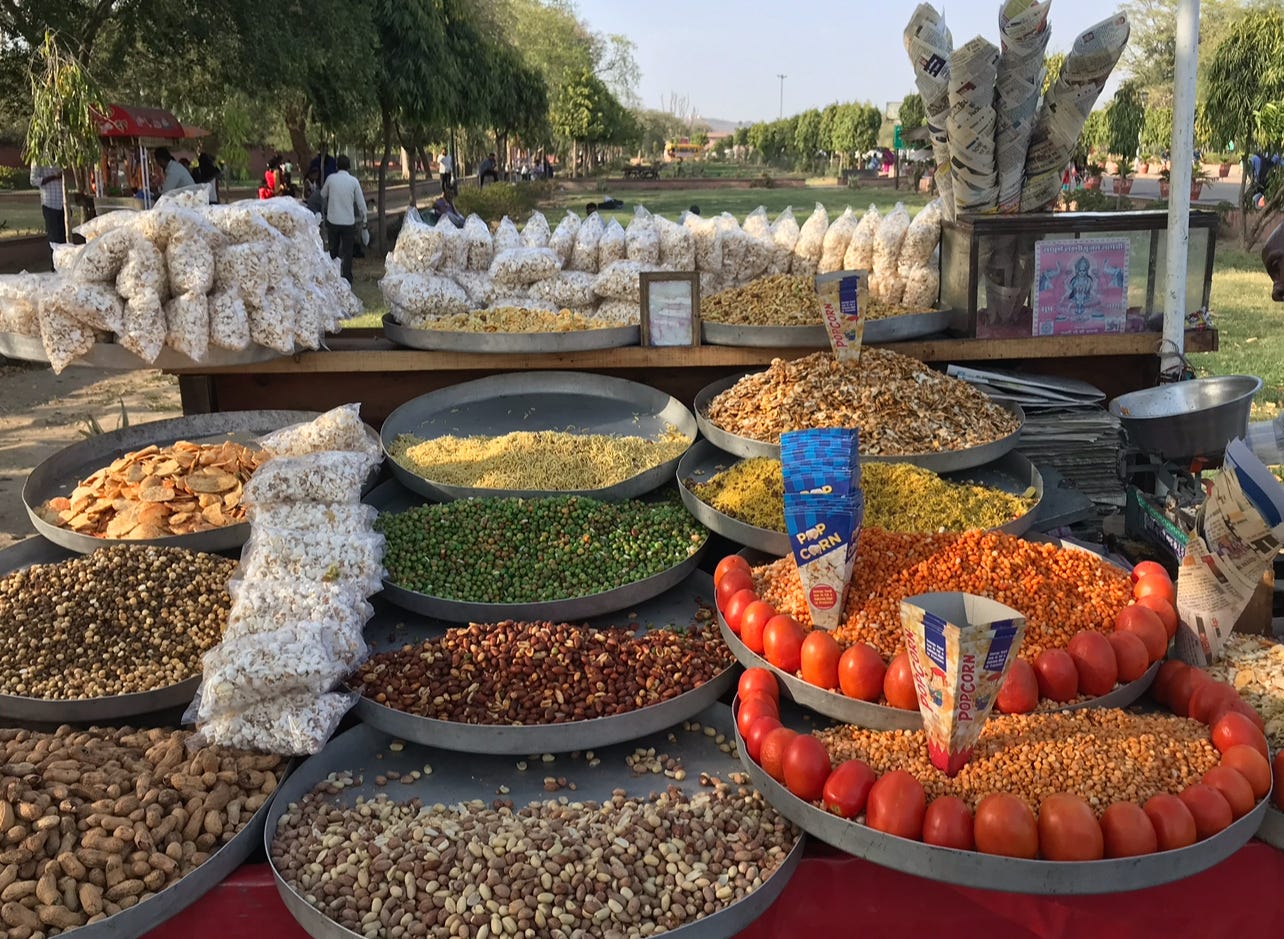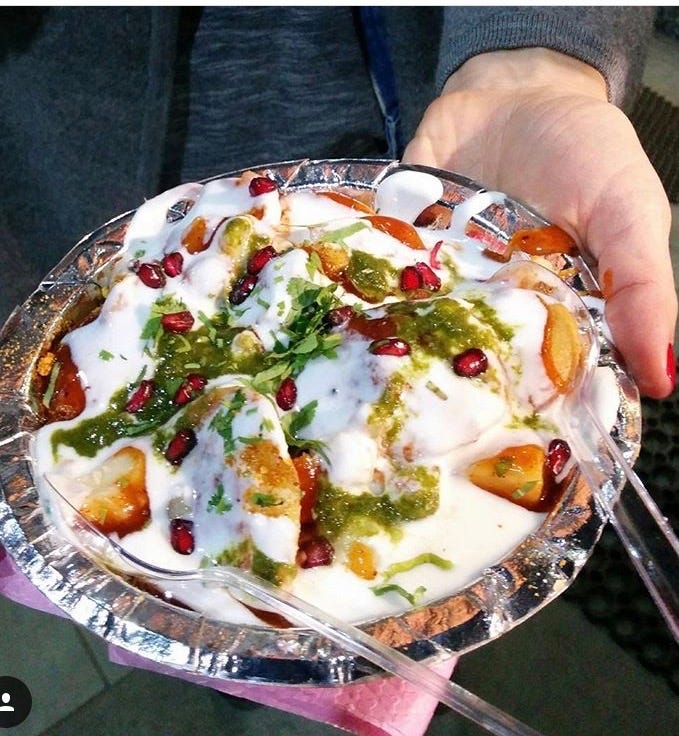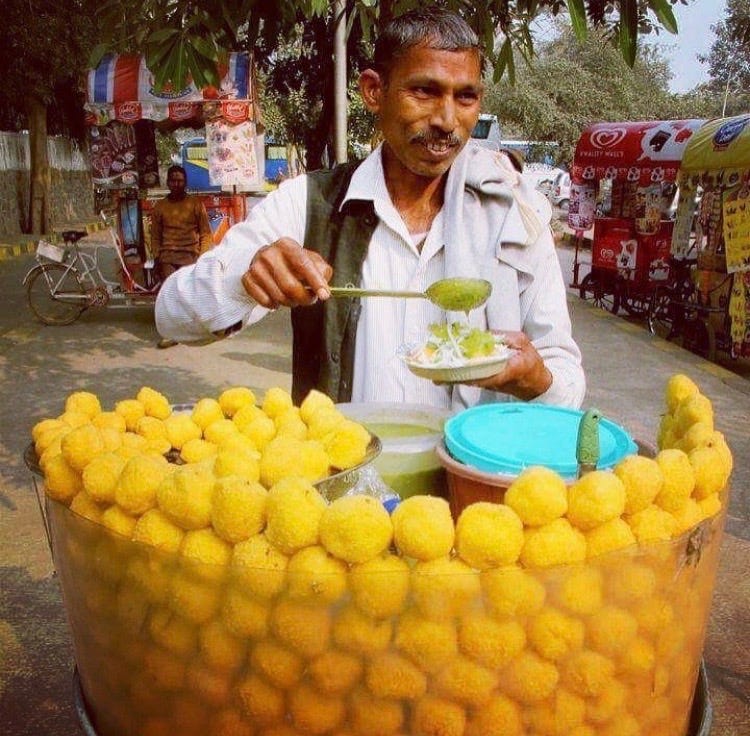It's Chaat Party Season: A Guide to India's Favorite Snack and How to Bring It Home
with two of my favorite chaat recipes, a guide on how to host your own chaat party plus a glossary of essential ingredients to get your pantry ready for chaat season (which is actually every season)
India lives in several centuries at the same time.- — Arundhati Roy
Chaat isn’t one thing. It’s everything.
I’ve tried to record as many chaats as possible in my research notebooks during my visits to India.
It’s usually while standing in front of vendors serving dishes as intricate and layered as India itself, chaats that reflect the complexity of the country, shaped by the perpetual swirl of its streets, markets and train stations.
Once, after combing through my notes while co-writing my cookbook about chaat, I counted more than 900 chaats. That’s not a typo.
Chaats are not just recipes or street food staples, they are a living record of resourcefulness, ingenuity, and sensory curiosity. They rarely rely on luxurious ingredients. Instead, they draw from what’s available: a boiled potato, a handful of sprouts, a spoonful of tamarind pulp, deftly chopped tomatoes, a sprinkle of sev, a dusting of chaat masala.
They are shaped by the seasons and by the creativity of the people making them, vendors and home cooks who know exactly how to coax flavor and tell a story from the simplest elements.
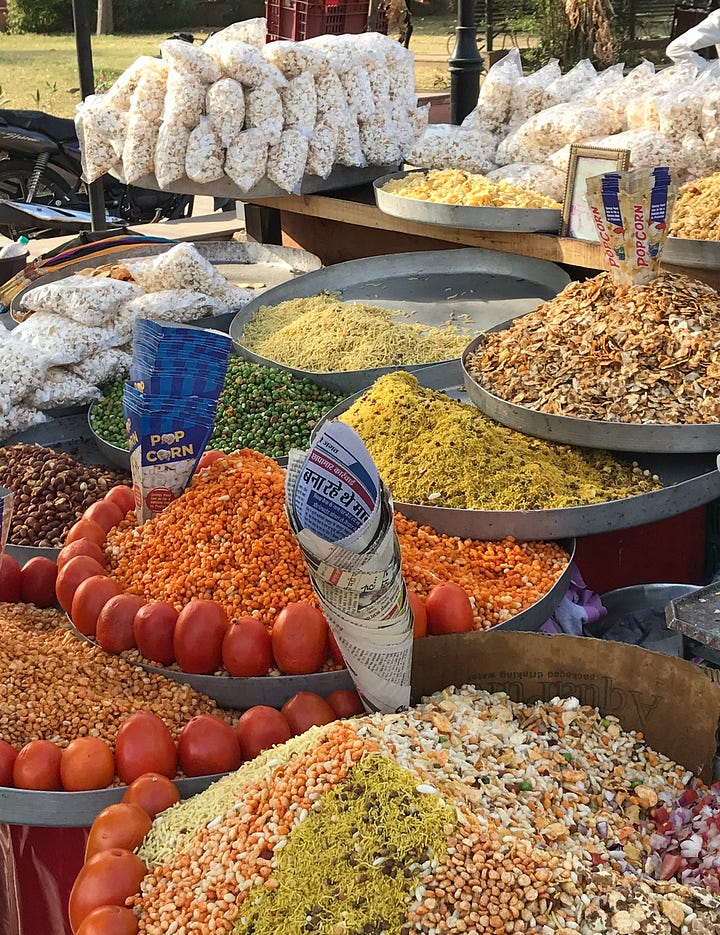
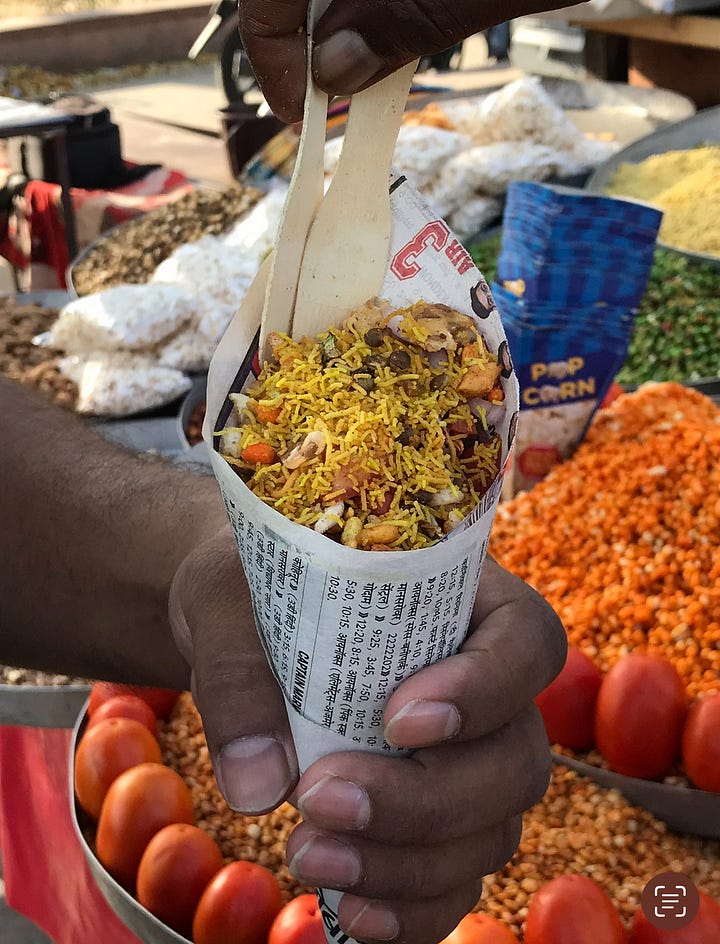
Chaats reflect an understanding built over centuries…how to balance sour with heat, crunchiness with creaminess, restraint with indulgence, vivid colors with warm, toasty hues.
They carry influences from trade, migration, suffering, joy, and memory. And they thrive not on excess but on precision, on knowing just when to add the lime juice or how long to toast the cumin. Each chaat is an act of everyday alchemy, turning very little into something unforgettable.
There are the universal chaat classics: bhel puri, papdi chaat, pani puri, aloo tikki. You’ll find versions of those just about everywhere. But the diversity of chaat across India is where it gets really exciting.
I’ve been to India more than fifteen times, zigzagging my way across every corner of the country by train, car, rickshaw and once, memorably, in the back of a bus for 21 hours traversing the highest drivable mountain peak in the world from Leh in the Himalayas to Manali in Himachal Pradesh.
From the snowy peaks of Ladakh to the spice-laced corridors of Kerala, I’ve tasted my way through the country’s kitchens, markets, train stations and street corners. No matter where I go, one thing connects the country more than anything else I’ve encountered. Chaat.
Chaat is not a dish. It’s a mood. A tribute to history. The love of a grandmother. The pain of loss. The thrill of victory. The comfort of togetherness. A moment. A revelation in a banyan leaf bowl.
Chaat is India’s snack culture in full technicolor, and if you’ve never had it, the closest comparison I can offer is to imagine a tapas party, but with more chaos, more heat, more tanginess, more crunch, more color, more sensory overload. And a lot more chutney.
I became so obsessed with chaat that I wrote a book about it with chef Maneet Chauhan. Chaat: Recipes from the Kitchens, Markets, and Railways of India is a tribute to these snacks, and the people who make and eat them.
But my love for it didn’t begin with a recipe. It started with standing, elbow-to-elbow, in the swirl of a train station crowd, eyes locked on the artistry of a vendor’s hands as he tossed puffed rice with raw onions, tamarind chutney, tomatoes, sprouted mung beans, raita, and a flurry of sev that landed like edible confetti.
There was no turning back.
The diversity of chaat is staggering. In Goa, you’ll find vinegar-soaked potato patties that nod to its Portuguese colonial past. In the South, coconut sneaks into chutneys and toppings. In Hyderabad, chaat leans into heat and tamarind. In Delhi, you’ll find fluffy ram ladoo (see recipe below….one of my favorites!) topped with cooling shaved radish and sweat-inducing green chutney. Even a simple sprouted lentil chaat can shift dramatically depending on where you are….and who’s making it.
A good chaat is a tightrope act of textures and tastes: tart and sweet, crisp and soft, creamy and spicy, all in a single bite. It’s a snack, but also a meal. It’s street food, but also something you can serve at the fanciest dinner party. It’s the kind of food that makes people gather. And linger. And come together.

A key idea behind chaat is contrast: hot vs cold, creamy vs crispy, sweet vs tart. You might start with a spoonful of sprouted mung beans, tossed with lime juice and umami-packed black salt, then move on to something fried, like a crunchy pakora.
Tamarind chutney brings tang, green chutney brings freshness, yogurt adds coolness, and chaat masala, a blend of spices that usually includes dried mango powder and black salt, ties it all together with a savory funk that’s hard to describe but impossible to forget. I truly can never be in my house without knowing there’s a jar of chaat masala in my cupboard.
I love many things about India.
I’m perplexed by just as many.
But one thing will never change. How strongly I feel that chaat is the culinary language that tells the truest and deepest story of this confounding, chaotic, wondrous country.
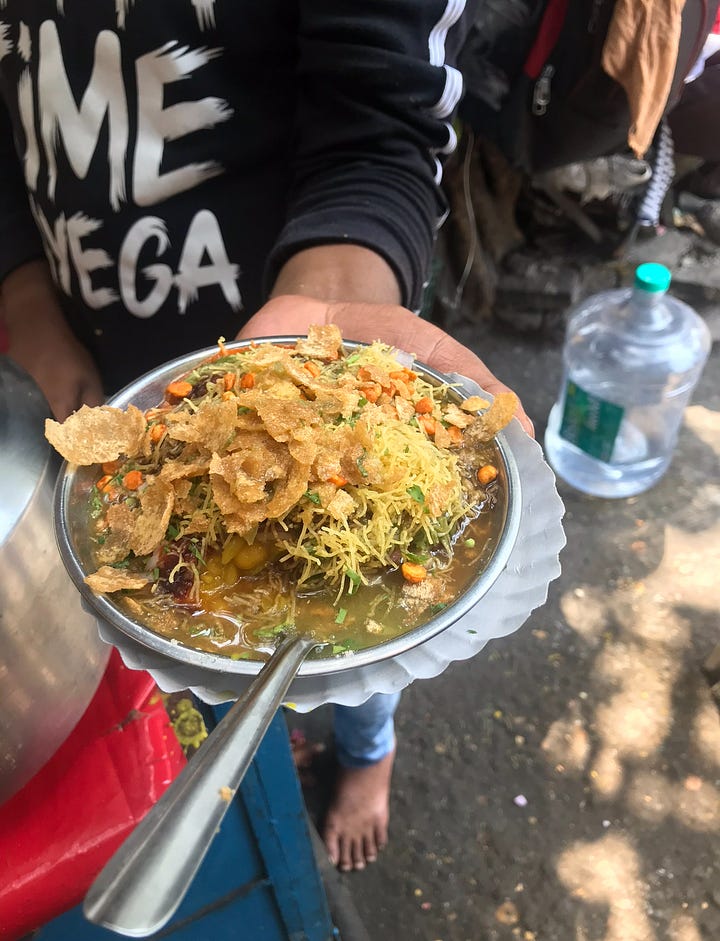
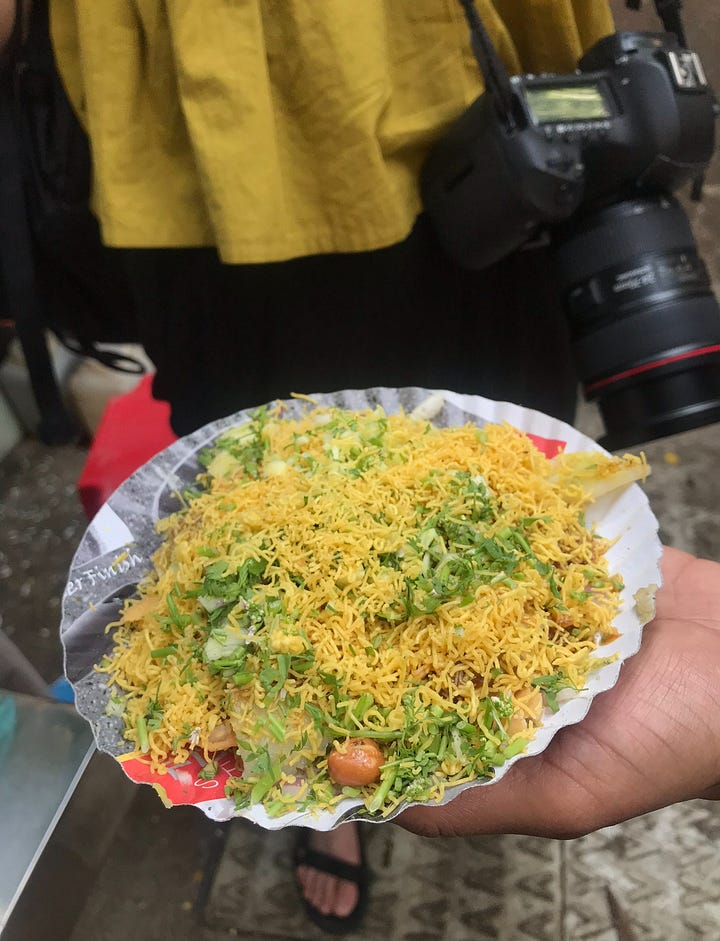
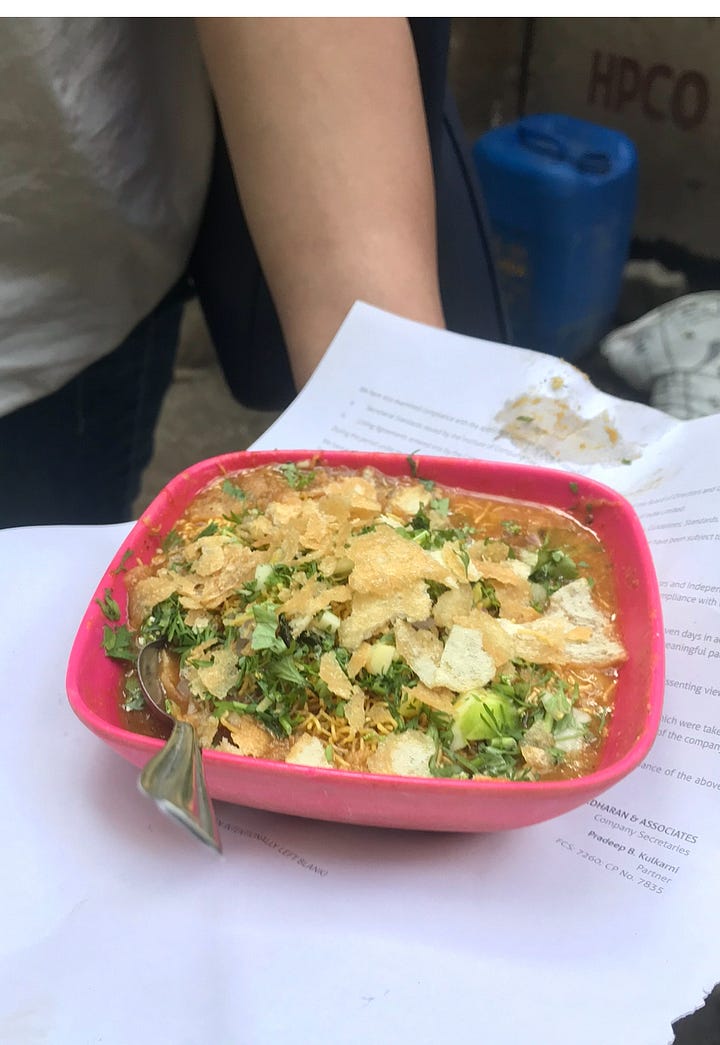
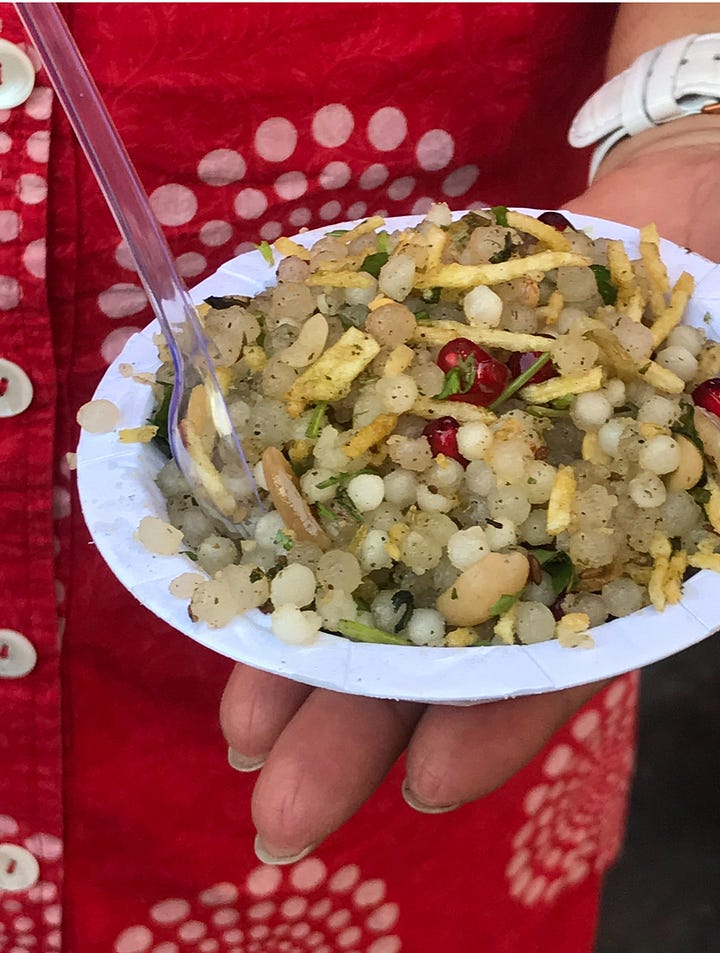
So why not throw a chaat party?
It’s the most fun way I know to gather people around a table.
Think of a chaat party as an Indian-style snack bar, where every dish is small, packed with flavor, texture, aroma, and color. And ready to be customized.
Unlike a formal dinner, it’s casual, fun and interactive. People mix and match, build their own bowls (and laugh as they do it) and try five or six things in one sitting without ever feeling weighed down.
It’s also a dream from a hosting perspective because much of it can be made ahead and assembled at the last minute.
The ingredients are mostly vegetables, fruits, legumes, and pantry staples, and many of the dishes are naturally vegetarian and gluten-free.
It’s vibrant food that doesn’t feel fussy and it leaves your guests talking about it long after the party ends.
Chaat is India.
And I wonder if there would be an India without chaat.
This week, I’m sharing recipes to get you started:
Free for All Subscribers:
Ram Ladoo – Fluffy moong dal fritters with radish and green chutney (potentially my favorite chaat, and that is really saying something).
For Paid Subscribers:
Bhel Puri – Puffed rice mixed with onions, chutneys, and sev
Plus a buying guide for the key items you need to stock your chaat pantry
And now...
How to Throw a Chaat Party
You don’t need to overthink it! Here’s how to get started:
Pick 3–4 chaat dishes
Offer variety: something crunchy (like bhel puri), something hearty (like sprouted bean chaat), something warm (like ram ladoo or aloo tikki), and something cooling (like yogurt-based papdi chaat).Make a chutney bar
Green chutney, tamarind chutney, and garlic chutney are the holy trinity. Add chopped cilantro, grated radish, and pomegranate seeds for bonus garnishes.Prep ahead and assemble to order
Keep components in separate bowls: boiled potatoes, puffed rice, cooked lentils, chutneys, chopped onions, fried snacks. Let guests mix their own or assemble small plates to pass around.Add a drink station
Masala chai, sweet lime soda, or a tamarind refresher make great nonalcoholic pairings. Spiked mango lassi or gin with black salt and lime are fun if you're serving cocktails.Keep it casual! Don’t stress!
Use small bowls or plates. Set everything out buffet-style or on a big shared table. Don’t worry if it gets a little messy, that’s part of the fun.
A Mini Guide to 12 Iconic Chaats
Your Starter Guide to India’s Most Irresistible Snacks
Consider this your cheat sheet for navigating the dazzling world of chaat. These are the heavy-hitters, the crowd-pleasers, the bite-sized wonders that show up from Kashmir to Kanyakumari, each one layered with history, regional quirks, and a whole lot of flavor.
Bhel Puri (recipe below for paid subscribers)
Puffed rice tossed with chopped onions, tomatoes, tamarind chutney, green chutney, and a blizzard of sev. Crunchy, tart, sweet, and spicy, it’s a beachside essential in Mumbai but you’ll find it everywhere in India, each recipe having its own regional variations.
Pani Puri (also called Golgappa or Puchka)
Crispy hollow puris filled with spiced mashed potatoes and dunked in chilled, spiced water. Pop the whole thing in your mouth before it bursts, this is not a two-bite snack. I serve pani puri all the time and seriously, it’s the best and fastest way to get your guests laughing as they pop these baffling wonders into their gaping mouths.
Papdi Chaat
Crisp wafers topped with boiled potatoes, yogurt, chutneys, and pomegranate seeds. A riot of textures that are cool, creamy, crumbly, tangy, and crisp.
Aloo Tikki Chaat
Golden-fried potato patties smothered with chickpeas, chutneys, yogurt, and crunchy toppings. A north Indian favorite that eats like a meal.
Dahi Puri
A cousin of pani puri, but creamier and more decadent, it’s filled with spiced potatoes and chickpeas, drizzled with yogurt and chutneys, and finished with crunchy sev.
Samosa Chaat
A smashed samosa reborn, split open and piled high with chana, yogurt, tamarind, mint chutney, onions, and coriander. The ultimate samosa glow-up!!
Sev Puri
Stacks of papdi layered with diced potatoes, onions, and chutneys, finished with a generous dusting of sev. Sharp, bright, and crunchy.
Raj Kachori
The showstopper. A giant, hollow puri filled with boiled potatoes, sprouts, yogurt, chutneys, and sometimes pomegranate. A full-on chaat experience that makes you feel ridiculously indulgent and contentedly smug all at once.
Dhokla Chaat
Soft, spongy fermented chickpea cakes turned into a snack with green chutney, grated coconut, and mustard seed tempering. A Gujarati classic with a chaaty twist.
Moth Chaat
Made with sprouted moth beans (mung beans), this one is fresh, lemony, and protein-packed. It’s common at train stations across the north.
Idli Chaat
From the South this chaat features slices of idli (steamed rice cakes that are puffed and fluffy) pan-fried until golden and tossed with chutneys, onions, and chaat masala.
Ram Ladoo (see recipe below)
Fluffy moong dal fritters served hot and topped with grated radish and green chutney. Light as air, with a peppery kick from the radish.
News & Favorites & Chaat Inspiration
Chaat: Recipes From the Kitchens, Markets and Railways of India My cookbook that I co-write with chef Maneet Chauhan features nearly 100 chaat recipes (plus several other Indian street food staples). Chaat won the IACP award for Culinary Travel, was longlisted for the Art of Eating Prize and named one of the best cookbooks of the year by Food Network, Salon, Epicurious, Garden & Gun and Wired.
101 Fantasy Feasts: This week in my other newsletter 101 Fantasy Feasts, we’re goign to be brillig in the slithy toves! Every Friday, I share one chapter from 101 Fantasy Feasts (so far, feasts from the Pixar movie Coco, the movie Big Night, the movie and book Chocolat and The Green Wedding from Game of Thrones have been featured). It’s a project that includes 101 feasts inspired by the most iconic meals from film, television, and literature, reimagined as real-life gatherings you can recreate. From the whimsical to the dramatic, each feast includes menus, setting details, party ideas, and five original recipes. It’s been a true labor of love (a project that I started on a whim during the pandemic when I missed gathering with people that now includes 101 feasts!), and I’m excited to finally begin sharing it with you. This series will run alongside my regular weekly newsletter, so you’ll still get your usual post, plus a little extra creative inspiration every Friday.
The Storied Table: The Storied Table is a new event series a long time in the making, inspired by the research and travel behind my recent cookbooks Elysian Kitchens and Eat Like a Monk. Through those books, I spent time in monasteries, temples, and sacred spaces around the world, learning how food can be a quiet act of devotion, connection and community. The Storied Table brings those experiences to life, offering communal meals from regional chefs and food producers in extraordinary places that carry their own sense of ritual, history, and beauty. We’re currently lining up a series of upcoming events (Minnesota, Lebanon, Upstate New York, Santa Fe, Northern California, England, Morocco, Ireland, Korea, Japan, Portugal and Spain are a few of the locations where we’re currently planning), with tickets for the inaugural gatherings going on sale July 1st. I’ll be sharing more about the inspiration and vision in future posts, but in the meantime, you can explore what we’re building at thestoriedtable.co and our Instagram.
Eat Like a Monk: A Plant-Based Guide to Conscious Cooking and Mindful Eating: I had a book published last year by Simon & Schuster comprised of plant-based recipes primarily inspired by Buddhist monasteries throughout Asia. I wrote about Eat Like a Monk in a recent post that includes a few vibrant recipes from the book.
My newsletter is reader-supported.
Free subscribers get limited access to the weekly newsletter and two weeks worth of archives.
Paid subscribers get complete access to all of the content in my newsletters and my entire archives. You’ll also get all of the recipes, guides, interviews, cooking tips, essays and more, plus the ability to comment and participate in discussions.
Newsletters will arrive right in your Inbox or you can read them through the app.
Ram Ladoo
Makes approximately 24 fritters
Serves 6
Preparation time: 3 1/2 hours including 3 hours to soak the moong dal
Ram ladoo is a popular chaat throughout India but it’s especially beloved in New Delihi. It’s comprised of fluffy round lentil fritters that are crispy on the outside and airy on the inside. Their bright yellow color evokes the Delhi sun on a kurta-drenching summer day. This recipe instructs them to be served hot but the vendors of New Delhi, who stack them up in irresistible rows in their tiny stands, serve them cold and there’s really nothing better on a sweltering Delhi day. Ladoos are typically sweet spherical snacks sold all over India but I prefer this savory version. It’s believed that the first ladoos were used as medicine by the ancient Indian physician Sushruta. His nearly 2500 year old tome, one of the first and most important medical texts ever written, forms the foundation of Ayurvedic cuisine with instruction on how to use seven hundred plants medicinally. Sushruta prescribes sesame seed ladoos to his patients as a medicinal cure. I’m not sure if he’d consider ram ladoos a cure-all but when topped with a handful of refreshing grated radish and fiery green chile chutney, they certainly could be considered a cure-all.
1 cup moong dal
1 cup chana dal
1 tablespoon freshly grated ginger
2 teaspoons turmeric
1 teaspoon hing
Oil, for frying
Salt to taste
Grated daikon radish, for garnish
Cilantro-mint chutney, for garnish Radish
To make the ram ladoo, rinse both lentil varieties together in a colander before transferring to a large bowl cover with enough water to double the height of the lentils. Soak for 3 hours before draining. Transfer to a food processor and blend at medium speed until the lentils form a thick paste. Increase the speed to high and blend until light and fluffy. Add the hing, ginger and turmeric and blend until incorporated. The mixture should have the consistency of light cake batter.
Pour enough oil into a large, heavy-bottom saucepan to reach about 2-inches from the top of the pan. Heat the oil to 325° Fahrenheit. While the oil heats, line a plate with a double layer of paper towels. Using a slotted spoon, drop 1-inch balls of batter into the oil. Do not overcrowd the fritters. The fritters should immediately rise to the surface of the oil. Fry until they are just starting to turn golden brown and are cooked through, about four minutes. Use the spoon to turn the fritters to ensure even cooking and coloring. Transfer to a plate and season with salt. Repeat with the remaining batter. While the fritters are still hot, arrange 3 or 4 of them on a small plate, top with a generous handful of radish and drizzle with chutney. Serve immediately.
Recipe from Chaat: Recipes From the Kitchens, Markets and Railways of India
For paid subscribers:
The rest of this post includes an additional recipe from my cookbook Chaat (another one of my favorites):
Bhel Puri – Puffed rice mixed with onions, chutneys, and sev
There’s also a buying guide for the 12 key items you should stock your pantry with so you’re ready to go whenever the impulse to throw a chaat party strikes you (you might think that will never happen but believe me, once you’re hooked on chaat, you’ll want to host them all the time)!






